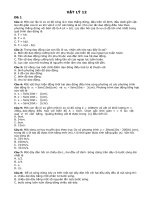VẬT lý địa CHẤN 12 freq
Bạn đang xem bản rút gọn của tài liệu. Xem và tải ngay bản đầy đủ của tài liệu tại đây (553.92 KB, 21 trang )
Overview
Fundamentals
Introduction
Seismic waves: Propagation Velocity and Amplitudes
Seismogram
Measurement systems
Sources, receivers, Acquisition strategies
Data processing
“Pre-processing”
Filter und Deconvolution
Velocity analysis and Stacking
Migration
Interpretation
Basic scheme of the seismic data processing
Loading of the data/conversion
Demultiplexing
Geometry
Measurements
Navigation
Pre-Processing
Editing
Amplitude correction
Frequency filter
Deconvolution
CMP-Sorting
Prestack
Velocity analysis
NMO-Correction
Stacking
Migration
Poststack
Post-processing
Printing/storage
Printing/storage
Frequency analysis
• Analysis of the frequency content of the
data
• Difference in frequency content for
interface waves, Noise and Reflections
• In what frequency range are the reflections
present ?
Outline
• Periodic and transient waveforms
• Fourier transformation
time domain <-> frequency domain
• Frequency filters
• Tapering
• Field examples
Frequency content of a shot
high freq.
noise:
low freq.
ground-roll
Waves
Amplitude
Phase φ
Acos(2πft)
Acos(2πft-φ)
t
1
Period τ ==--f
Period τ
Wavelength λ=τ∗v
2π
Wavenumber k = --λ
Velocity v
=
f⋅λ
2π
-----ω
Periodic and transient waveforms
Periodic waveform
Transient waveform
Periodic waveforms
• Any periodic waveform, may be
decomposed into a series of sine (or cosine)
waves whose frequencies are integer
multiples of the basic repetition frequency
• It is necessary to define not only the
frequency of each component, but also its
amplitude and phase
Fourier transformation
Fourier Transformation:
∞
G( f ) =
−i 2 πft
(
)
g
t
e
dt
∫
−∞
G( f ) =
∞
∞
−∞
−∞
∫ g (t )cos(2πft )dt − i ∫ g (t )sin(2πft )dt
∞
Inverse Fourier
Transformation:
g (t ) = ∫ G ( f )e i 2πft df
−∞
∞
∞
−∞
−∞
g (t ) = ∫ G ( f ) cos(2πft )df + i ∫ G ( f )sin( 2πft )df
Summation of different frequencies
Fourier transformation
g(t)
A(f)
Amplitude-Spectrum
φ(f)
Phase-Spectrum
G(f) = A(f) e iφ(f)
where A(f)={[Real part of G(f)]2+[Imaginary part of G(f)]2}1/2
Φ (f)=tan-1
(
imaginary part of G(f)
real part of G(f)]
)
A(f)
Imaginary part
Φ (f)
Real part
• frequency
• amplitude
• phase
f1
f2
Sum:
f1
f2
Sum:
f1
f1
f2
f2
Sum:
Sum:
Digital representation of continuous amplitude and phase spectrum
associated with a transient waveform
Spike function
DC bias
Transient waveforms
approximating
seismic pulses
Frequency filter
Low Pass
High Pass
f
f
Notch filter
Band Pass
f
f
Tapering
Tapering of filters
• Butterworth
• Hanning
• Ormsby
Amplitude and phase characteristics.
Band-pass filtered raw field records
Corrected for geometric spreading: frequency absorption remains









